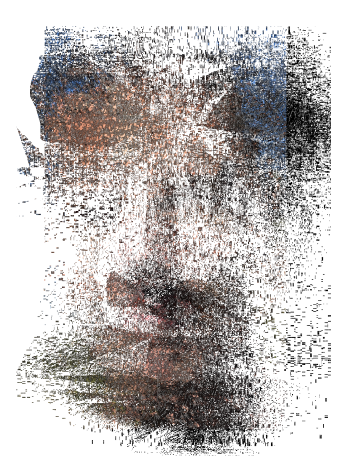Monthly Archives: September 2020
28/09/20 Capitalist Coup in Hell

Hell isn’t what it used to be.
Charon was forced into retirement after some influential sinners complained about his indiscriminate brutality. His ferryboat can be found on display in the Hell History Museum. New arrivals now enjoy a luxury passenger ship, though the River Styx can be crossed by airplane too. After fingerprinted and photographed, arrivals pass under the new entrance gate sign: “You are now entering Hell. Welcome.” (“All hope abandon, ye who enter here” was retired too.)

The smell is bad, a combination of sulphur and automobile fumes, but lessened by the scent of perfume—now one of the leading industries in the region. Cerberus is spritzed daily. Visitors and favored sinners can enjoy a taxi to the Grand View to acclimate to the heat before continuing on. Be sure to stop by the Limbo Club, where the ancient philosophers and bards have been joined by other impractical and so potentially disruptive thinkers, including Karl Marx, Thoreau, Isadora Duncan, and Eugene Debs. Visits are limited to one hour.

According to the last census statistics, two-thirds of the Devils you meet will be former sinners from the Upper World. The remaining are either original Bad Angels of Heaven or their descendants (inbreeding and bestiality has resulted in a range of Minotaurs, Harpies, Houndbats, Goatguamps, and other variegated races of Fiends, Demons, Jinks, and Imps). The original inhabitants should not be called Fallen, since Hell’s past isn’t quite what it used to be either. Recent investigations reveal that when Lucifer and his fellow rebels warred against Heaven, they were victorious, forcing God into a peace conference where He signed a treaty ceding the subterranean regions.

Lucifer isn’t his old self either. The early years of the twentieth-century saw an influx of robber baron capitalists, who forced the ruler to abdicate his thrown in order to modernize damnation. The new Money Power government was soon printing its own currency and reaping the considerable benefits. Now Lucifer is truly Fallen, reduced to the ceremonial duties of parades and radio addresses. He and his PR advisor, Beelzebub, play a lot of cards in his palace office.
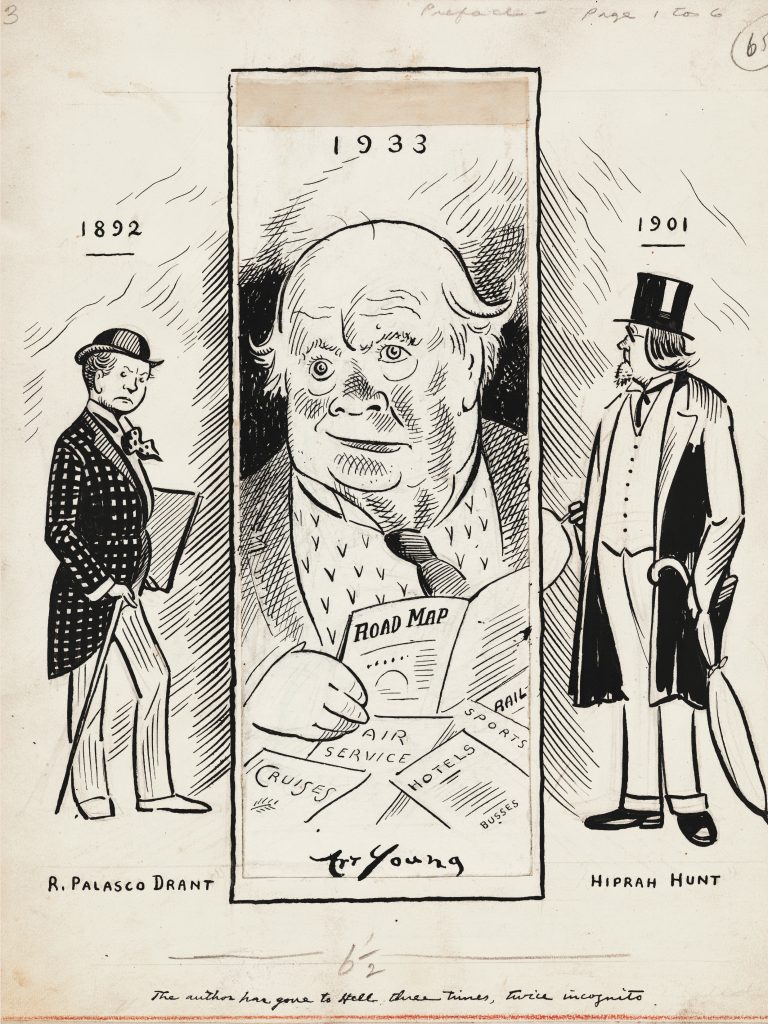
All of the above facts were directly observed and carefully illustrated by cartoonist Art Young during his six-week visit to the underworld in 1934. He traveled there by New York City elevator. It was his third trip. The first two were in 1892 and 1901, well before the capitalist revolution and his own conversion to socialism. Steven Heller, who writes the foreword for the new Fantagraphics edition, asks: “Would he and Bernie Sanders be comrades?” By way of answer, Heller points to Young’s four-level chart dividing the inhabitants of Hell into economic groups. The “Poor” are heaped into literal mountains, while a tiny gathering sits atop the “Richer” shelf. Young doesn’t offer percentages, but I suspect Hell doesn’t have a wealth tax on that top .01%.
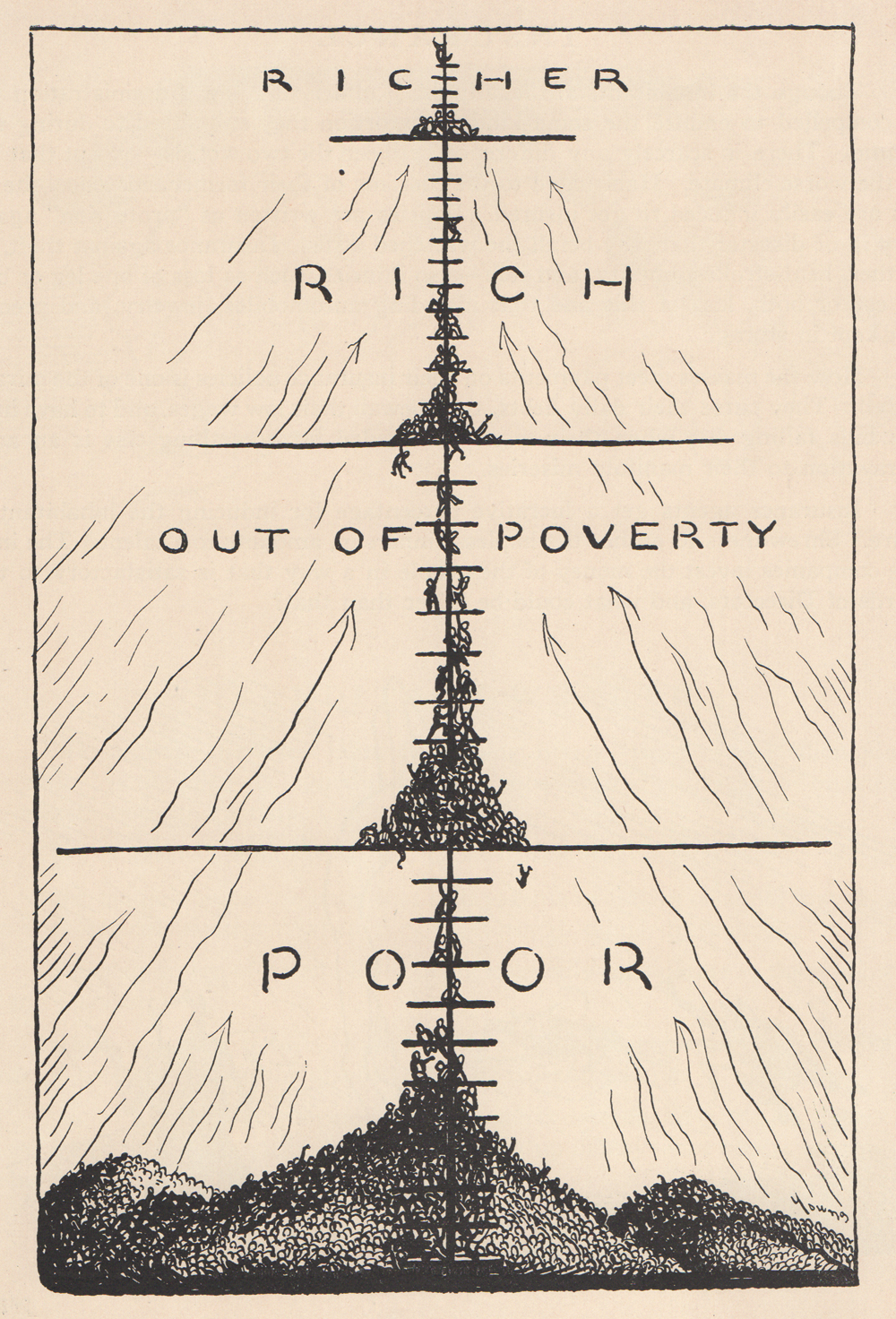
Young returns at a prescient moment. Though Senator Sanders was likely still a serious presidential contender when Fantagraphics decided to republish Inferno, they could not have predicted that the Depression-era satire would arrive during the pandemic and what may be the opening months of the Twenty-first century Depression. Apparently the last economic catastrophe was a boon for Hell, since it yielded a massive crop of “financial wizards” arriving by suicide. Instead of sending them to the suicide circle, the government assigned them to the Recovery Board to issue reports emphasizing “the necessity of generous loans to Big Business” and forecasting “much hope in the willingness of the most miserable sinners to work for almost nothing, or even go without work until business improves.”

It’s not necessary to have read Dante’s Inferno, or to have studied depictions of the underworld by Breughel, Blake, Doré, or centuries of other artists, but Young clearly has. The mild-mannered cartoonist (he draws himself squat and round-faced) is an aficionado of all things infernal. His love of Dante produced three comedies, though unlike The Divine Comedy, Young was content to keep sketching the bottom rung.
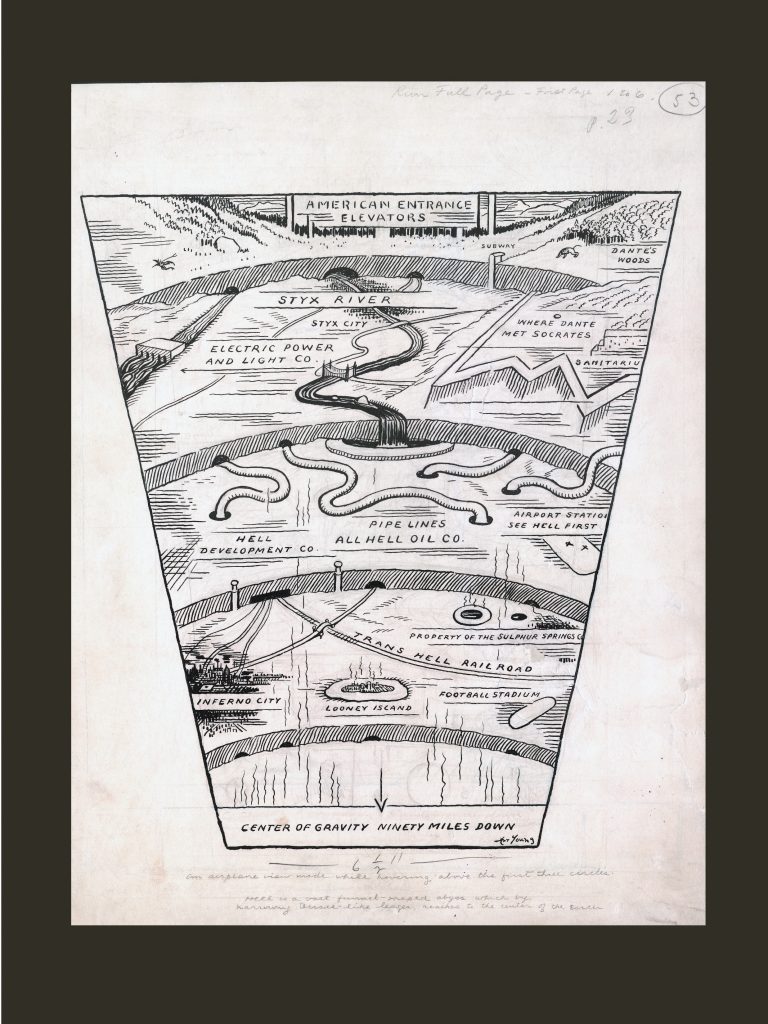
He opens with a retracing of Dante’s footsteps, but after literally mapping the Circles (now connected by elevators), he abandons the narrative approach for a random shuffle of vignettes titled by theme: The Scientists (they’re as useless as the bards), About Women (they’re as bad as the men), Heroism (limited to ruthless football players), and Snatches of Conversation Along The Streets (“Must get job,” “If it won’t sell, what good is it?”). The meandering is fun, but the early promise of a concluding interview with the dethroned Satan does preserve a little suspense.

Though Inerno is comic in the satirical sense, the book is not a comic book. Except in rare cases, words and images stand apart, and it’s hard to say whether the drawings illustrate the blocks of prose or if those paragraphs just provide an excuse for Young’s satirical cartooning. His subject and style are consistent, but some images are designed as quick dash-offs in the corners of pages, and others are meticulously crosshatched full-page reveries. Young’s pen, whether drawing or printing, is filled with the same critical wit.
If it’s not clear yet, his subject isn’t Hell but life on the U.S. portion of Earth. Where Dante and his other predecessors were Christians providing imaginary evidence of the future waiting the faithless, Young’s social commentary seeks to punish the abusively wealthy in the here and now. I suspect most shrugged off the criticism as easily in 1934 as their descendants will in 2020. If Young made it to cartoon heaven, I can easily imagine the fun he’s having right now sketching the Robber-Baron-in-Chief in the White House.
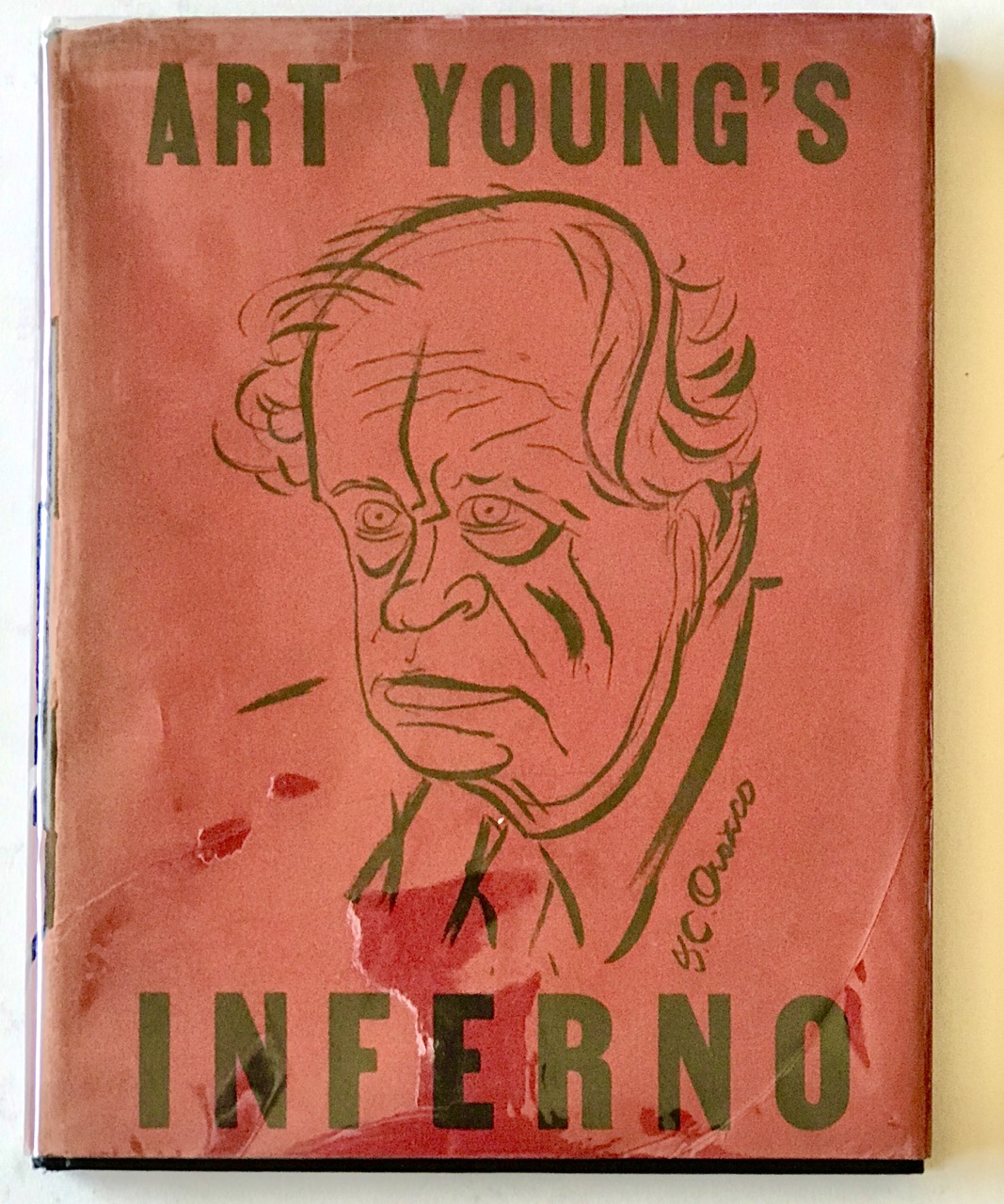
Tags: Art Young, Fantagraphics Books, Inferno, May 2020
- Leave a comment
- Posted under Uncategorized
21/09/20 End Gerrymandering Now: Vote YES on Amendment 1
I made this bumper sticker back in January 2017. I just added “Vote YES on Amendment 1” because that is THE BEST WAY to stop gerrymandering in Virginia.
There is a lot of misinformation about the amendment and the notion that some other amendment could replace it. That’s a manipulative distraction. Because it all comes down to this:
If you want the Democrats in Richmond to be free to gerrymander when they draw the new maps in 2021, then vote NO.
But if you believe gerrymandering is wrong regardless of which party is in power, then vote YES.
Here’s why:
ONLY an amendment can stop a 2021 gerrymander.
The anti-gerrymandering law that was passed in 2020 is MEANINGLESS. The legislature can do ANYTHING they like with the new maps because the Virginia constitution gives them complete, unfettered power. No law can change that.
And this has to happen NOW. New maps MUST BE DRAWN next year. There’s no stopping that. It can’t be paused for two legislative sessions and a general election as some other theoretical new amendment is approved.
And I mean literally RIGHT NOW. Voting has started. There’s no pause button for that either.
I’m hearing a lot distracting noise about the amendment not being perfect. Obviously it’s not perfect. But it is VERY GOOD.
It guarantees that the two parties will be forced to work together and draw maps that favor neither side. That is the ONLY REASON a redistricting commission exists, and the amendment achieves that goal.
I keep hearing distractions about the commission not being “independent.” What does that even mean? The point is to lock the two parties into a forced position where compromise is their only option. The amendment does exactly that.
I hear distractions about the commission having too many “elected officials” or that the parties are in too much control of who serves on it. THAT IS THE POINT of the commission.
The two parties get 8 members each, and then at least 12 members have to agree on a map. It’s aggressively bipartisan with no option but compromise. THAT is how you end gerrymandering.
But if Amendment 1 fails, we will be left only with the promise of some theoretical replacement amendment that can’t be ratified until after the new maps have been drawn without anything preventing them from being gerrymandered.
It’s either Amendment 1 or crossing your fingers and hoping that the Democrats in Richmond will set aside all partisan and personal interests and draw fair maps when they have complete power to make them as unfair as the GOP maps were against Democrats for the past decade.
The majority party gerrymanders. That’s why it’s so incredibly difficult to stop the perfectly legal but entirely anti-democratic practice. Virginia voters have ONCE CHANCE to do this, and it’s RIGHT NOW.
If you believe in fairness and principles, vote YES.
If you believe in revenge and hypocrisy, then vote NO.
Or maybe you actually think the Richmond Democrats are above gerrymandering? That our side are the “good guys,” and it’s only those “bad guy” Republicans who would ever do something so terrible as gerrymandering?
Grow up.
I’m not going to gamble away this amendment on a roll of the dice and the blind hope that incumbents will all suddenly become superhuman angels overnight. We’re talking about politicians.
Power corrupts. Gerrymandering has proven that again and again and again.
END IT NOW.
Here’s how the amendment looks on the ballot:
Virginia Question 1, the Redistricting Commission Amendment:
A “yes” vote supports transferring the power to draw the state’s congressional and legislative districts from the state legislature to a redistricting commission composed of state legislators and citizens.
A “no” vote opposes transferring the power to draw the state’s congressional and legislative districts to a redistricting commission, thus keeping the state legislature responsible for redistricting.
And here’s the complete text of the amendment (I’ve placed what I consider key points in red for easy skimming):
Section 6. Apportionment.
Members of the House of Representatives of the United States and members of the Senate and of the House of Delegates of the General Assembly shall be elected from electoral districts established by the General Assembly pursuant to Section 6-A of this Constitution. Every electoral district shall be composed of contiguous and compact territory and shall be so constituted as to give, as nearly as is practicable, representation in proportion to the population of the district. Every electoral district shall be drawn in accordance with the requirements of federal and state laws that address racial and ethnic fairness, including the Equal Protection Clause of the Fourteenth Amendment to the Constitution of the United States and provisions of the Voting Rights Act of 1965, as amended, and judicial decisions interpreting such laws. Districts shall provide, where practicable, opportunities for racial and ethnic communities to elect candidates of their choice.
The General Assembly shall reapportion the Commonwealth shall be reapportioned into electoral districts in accordance with this section and Section 6-A in the year 2011 2021 and every ten years thereafter.
Any such decennial reapportionment law shall take effect immediately and not be subject to the limitations contained in Article IV, Section 13, of this Constitution.
The districts delineated in the decennial reapportionment law shall be implemented for the November general election for the United States House of Representatives, Senate, or House of Delegates, respectively, that is held immediately prior to the expiration of the term being served in the year that the reapportionment law is required to be enacted. A member in office at the time that a decennial redistricting law is enacted shall complete his term of office and shall continue to represent the district from which he was elected for the duration of such term of office so long as he does not move his residence from the district from which he was elected. Any vacancy occurring during such term shall be filled from the same district that elected the member whose vacancy is being filled.
Section 6-A. Virginia Redistricting Commission.
(a) In the year 2020 and every ten years thereafter, the Virginia Redistricting Commission (the Commission) shall be convened for the purpose of establishing districts for the United States House of Representatives and for the Senate and the House of Delegates of the General Assembly pursuant to Article II, Section 6 of this Constitution.
(b) The Commission shall consist of sixteen commissioners who shall be selected in accordance with the provisions of this subsection.
(1) Eight commissioners shall be legislative members, four of whom shall be members of the Senate of Virginia and four of whom shall be members of the House of Delegates. These commissioners shall be appointed no later than December 1 of the year ending in zero and shall continue to serve until their successors are appointed.
(A) Two commissioners shall represent the political party having the highest number of members in the Senate of Virginia and shall be appointed by the President pro tempore of the Senate of Virginia.
(B) Two commissioners shall represent the political party having the next highest number of members in the Senate of Virginia and shall be appointed by the leader of that political party.
(C) Two commissioners shall represent the political party having the highest number of members in the House of Delegates and shall be appointed by the Speaker of the House of Delegates.
(D) Two commissioners shall represent the political party having the next highest number of members in the House of Delegates and shall be appointed by the leader of that political party.
(2) Eight commissioners shall be citizen members who shall be selected in accordance with the provisions of this subdivision and in the manner determined by the General Assembly by general law.
(A) There shall be a Redistricting Commission Selection Committee (the Committee) consisting of five retired judges of the circuit courts of Virginia. By November 15 of the year ending in zero, the Chief Justice of the Supreme Court of Virginia shall certify to the Speaker of the House of Delegates, the leader in the House of Delegates of the political party having the next highest number of members in the House of Delegates, the President pro tempore of the Senate of Virginia, and the leader in the Senate of Virginia of the political party having the next highest number of members in the Senate a list of retired judges of the circuit courts of Virginia who are willing to serve on the Committee, and these members shall each select a judge from the list. The four judges selected to serve on the Committee shall select, by a majority vote, a judge from the list prescribed herein to serve as the fifth member of the Committee and to serve as the chairman of the Committee.
(B) By January 1 of the year ending in one, the Speaker of the House of Delegates, the leader in the House of Delegates of the political party having the next highest number of members in the House of Delegates, the President pro tempore of the Senate of Virginia, and the leader in the Senate of the political party having the next highest number of members in the Senate shall each submit to the Committee a list of at least sixteen citizen candidates for service on the Commission. Such citizen candidates shall meet the criteria established by the General Assembly by general law.
The Committee shall select, by a majority vote, two citizen members from each list submitted. No member or employee of the Congress of the United States or of the General Assembly shall be eligible to serve as a citizen member.
(c) By February 1 of the year ending in one, the Commission shall hold a public meeting at which it shall select a chairman from its membership. The chairman shall be a citizen member and shall be responsible for coordinating the work of the Commission.
(d) The Commission shall submit to the General Assembly plans for districts for the Senate and the House of Delegates of the General Assembly no later than 45 days following the receipt of census data and shall submit to the General Assembly plans for districts for the United States House of Representatives no later than 60 days following the receipt of census data or by the first day of July of that year, whichever occurs later.
(1) To be submitted as a proposed plan for districts for members of the United States House of Representatives, a plan shall receive affirmative votes of at least six of the eight legislative members and six of the eight citizen members.
(2) To be submitted as a proposed plan for districts for members of the Senate, a plan shall receive affirmative votes of at least six of the eight legislative members, including at least three of the four legislative members who are members of the Senate, and at least six of the eight citizen members.
(3) To be submitted as a proposed plan for districts for members of the House of Delegates, a plan shall receive affirmative votes of at least six of the eight legislative members, including at least three of the four legislative members who are members of the House of Delegates, and at least six of the eight citizen members.
(e) Plans for districts for the Senate and the House of Delegates shall be embodied in and voted on as a single bill. The vote on any bill embodying a plan for districts shall be taken in accordance with the provisions of Article IV, Section 11 of this Constitution, except that no amendments shall be permitted. Such bills shall not be subject to the provisions contained in Article V, Section 6 of this Constitution.
(f) Within fifteen days of receipt of a plan for districts, the General Assembly shall take a vote on the bill embodying that plan in accordance with the provisions of subsection (e). If the General Assembly fails to adopt such bill by this deadline, the Commission shall submit a new plan for districts to the General Assembly within fourteen days of the General Assembly’s failure to adopt the bill. The General Assembly shall take a vote on the bill embodying such plan within seven days of receipt of the plan. If the General Assembly fails to adopt such bill by this deadline, the districts shall be established by the Supreme Court of Virginia.
(g) If the Commission fails to submit a plan for districts by the deadline set forth in subsection (d), the Commission shall have fourteen days following its initial failure to submit a plan to the General Assembly. If the Commission fails to submit a plan for districts to the General Assembly by this deadline, the districts shall be established by the Supreme Court of Virginia.
If the Commission submits a plan for districts within fourteen days following its initial failure to submit a plan, the General Assembly shall take a vote on the bill embodying such plan within seven days of its receipt. If the General Assembly fails to adopt such bill by this deadline, the districts shall be established by the Supreme Court of Virginia.
(h) All meetings of the Commission shall be open to the public. Prior to proposing any redistricting plans and prior to voting on redistricting plans, the Commission shall hold at least three public hearings in different parts of the Commonwealth to receive and consider comments from the public.
(i) All records and documents of the Commission, or any individual or group performing delegated functions of or advising the Commission, related to the Commission’s work, including internal communications and communications from outside parties, shall be considered public information.[6]
- 1 comment
- Posted under Uncategorized
14/09/20 My New Digital Paper Dolls
Someday I should really tackle Photoshop, or at least Adobe Illustrator. But I keep having too much fun inventing styles and techniques within the archaic simplicity of MS Paint.
- Leave a comment
- Posted under Uncategorized
07/09/20 Eldercare Twilight Zone

“I am Yukie Sakai, home help aide! And I’m here to help!!”
If that sounds like the tagline of a delightfully improbable superheroine, the crises that call her to action are even better: a legion of brutal grandchildren hunting their destitute grandfather down for New Year’s change; a senile Santa Claus giving gangsters rocket-launchers for Christmas; an elderly woman whose supernatural dementia rewrites history to match her delusions.
This is the eldercare Twilight Zone of manga artist Shintaro Kago’s Dementia 21, now extended into its second volume for English readers. The first included an interview with the artist, as well as opening stories that provide some grounding (Yukie keeps getting these demented assignments because a jealous colleague is blackmailing an executive to destroy her), but since each episode stands alone, Volume Two does too.
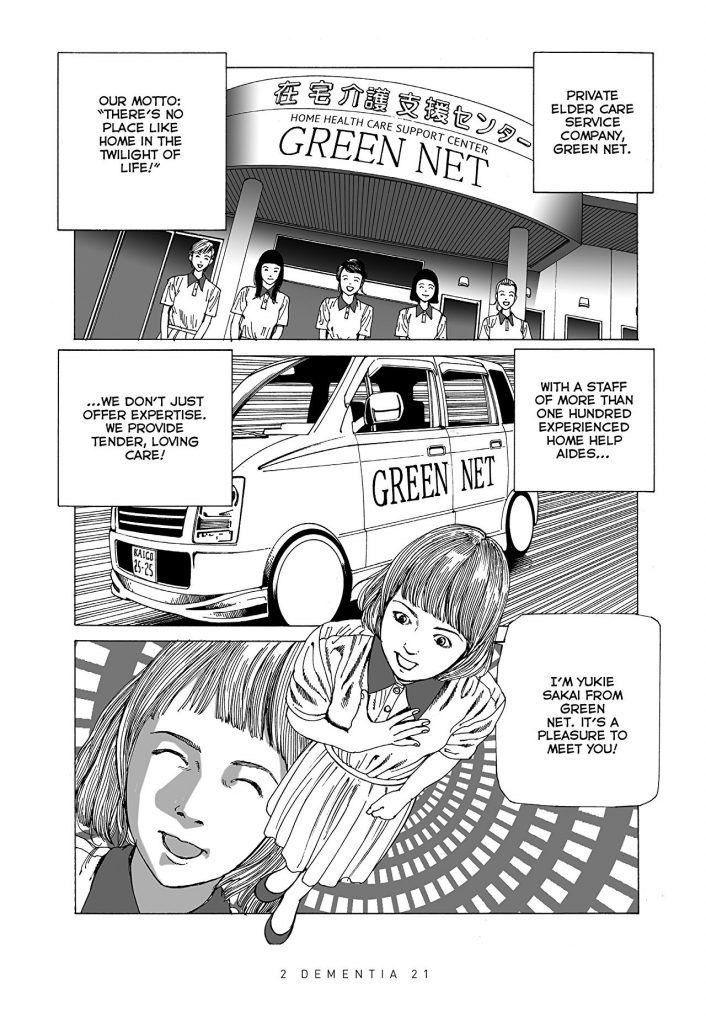
As much as I admire Kago’s oddness as a writer, his artistic pen is even sharper. Unlike so many typical manga characters, Kago’s cast avoids the cliché stylistic ticks of their genre and instead hover at the edge of naturalism. Though selectively cartoonish, even when simplified, Yukie and her clients retain a realistic edge that intensifies their horror-tinged universe. Kago wisely keeps his computer-generated graphics in the background, evoking the emotion of a moment through soft grays that swirl psychedelically or emanate in dramatic bursts. Best of all, the introductory page of each chapter—presumably covers or splash-pages for the original series—are surrealist mini-masterpieces.

Though you might expect Yukie to defeat each episode’s menace, you can’t count on her. She reassured poor Mrs. Furuike that the zombies employed at the nursing home were no threat, but that didn’t stop the nursing home from attaching her head to machines and feeding the rest of her body to the new staff. When a neighborhood of condos designed to look like bingo boards plays an elaborate game of chance by darkening a square of windows whenever an elderly tenant dies, Yukie doesn’t even try to stop them. She’s equally powerless when Japan’s government passes a law nullifying all crimes committed by senior citizens to reduce over-crowded prisons—never mind that the elderly, deprived of the comforts of prison, “descended into more profound depths of evil.”
The English translation by Rachel Thorn provides an appropriately colloquial tone to the dialogue, including idioms (“All right, all right. I get the message. I’ll leave!”) and slang abbreviations (“Whadda we gonna, do, boss?”). The chapter set 10,000 years in the future must have been a particular challenge since the humor is primarily word-based with a chief archaeologist (a descendant and namesake of Yukie) lecturing about the discovery of an ancient species called the “Ell-durly” who battled ancient homo sapiens with repellent “Bah-breff” and detachable teeth. Adages are harder, requiring an asterisk and footnote to explain why the archaeologist thinks eggplants were poisonous (they were once thought to inhibit fertility and so lead to the saying: “Don’t let your daughter eat autumn eggplants”).
The core premise of the series requires some cultural context too. Presumably a Japanese reader would know before the sixteenth chapter of the second volume that Japan has one of the highest elderly populations in the world: “I’m sure you’re aware that Japan’s population pyramid has become wildly distorted” with “increasingly more older people than younger people.” A heroine who works for a home aid corporation reflects that demographic fact and places all of the adventures in the realm of social commentary.
Unfortunately, no amount of cultural context can lessen Kago’s attitude toward rape. Yukie’s naked spirit is chased by the equally naked spirit of the inventor of a machine that forces out-of-body experiences: “Hi-de-ho! I may be old, but my disembodied spirit is as lively as ever.” Worse, according to the archaeologist’s theories, the male Ell-Durley “would attack a female homo sapiens … impregnate her … and keep her captive … while the fetus develops.” Worst off all, that demented Santa Claus rapes a child’s mother to fulfill the child’s wish for a baby brother. Dark or not, the humor does not translate.
Still, Kago is significantly less sexually exploitative than the manga market he later lampoons. he collection dips fully into meta-fiction as Kago draws himself redrawing the series to satisfy the requirements of an anime producer. The changes replace Kago’s style with generic manga effects: Yukie’s “rounder face,” “bigger eyes,” “more exaggerated expressions!” That new version also includes “longer legs,” “shorter skirt,” and “big boobs.” Instead of old people, she’s caring for young girls with sponge baths and glimpses of panties.
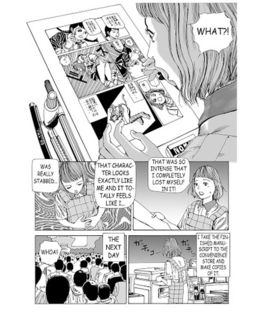
Like most of the tales, the meta-Kago’s ends tragically, but this time the collection transitions into a four-part sequence that appears to bring the series to an end—not that any of Kago’s endings seem definitive. After Yukie tricks death by giving herself a 10,000-year lifespan, even the future archaeologist remarks on internal inconsistencies: “Wait, I thought I was supposed to be your descendant in this book.”
Other tales appear to exist in parallel realities. According to chapter three, Yukie and the rest of the cast are just actors in an elaborate stage production. Chapter six depicts a global war against a legion of supernaturally sentient diapers, until the entire planet is swaddled in one enormous diaper which the human resistance causes to explode in confusion by intentionally urinating in their clothes. If that planet-wide cataclysm leaves any historical impression, it’s erased before the start of the next chapter, which itself ends with a child about to launch a world-ending nuclear missile strike.
The ending sequence brings a welcome arc to the series, initiating yet another war, this one between the elderly and the Japanese government attempting to exterminate them once and for all. Though I appreciate the extended storyline, it comes with the cost of Yukie, or at least her character consistency since the ever-kind aide transforms into a mercenary providing her talents and inside knowledge for a wad of cash. The instant conversion is a cute gag, in keeping with Kago’s increasing meta-approach, but I preferred the old Yukie. Granted, she was first rendered destitute by the agency that recruits her, transforming her first into a vengeful monster kidnapping her former clients to discover who framed her and got her fired from her beloved job.
But maybe that’s all an alternative timeline too, and the more lovable Yukie will return for a third volume?

Tags: Dementia 21, Kago, Vol. 2
- Leave a comment
- Posted under Uncategorized

